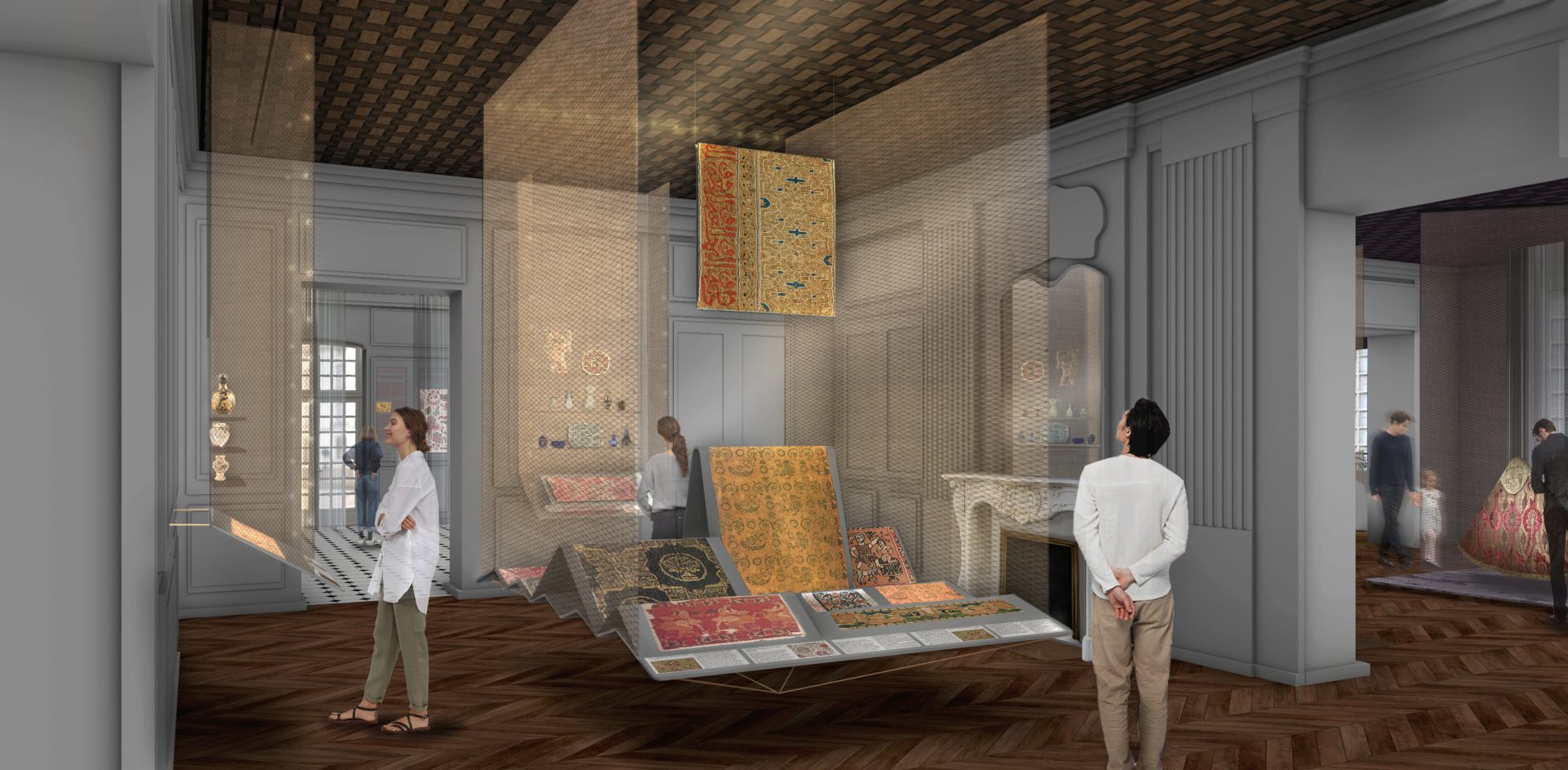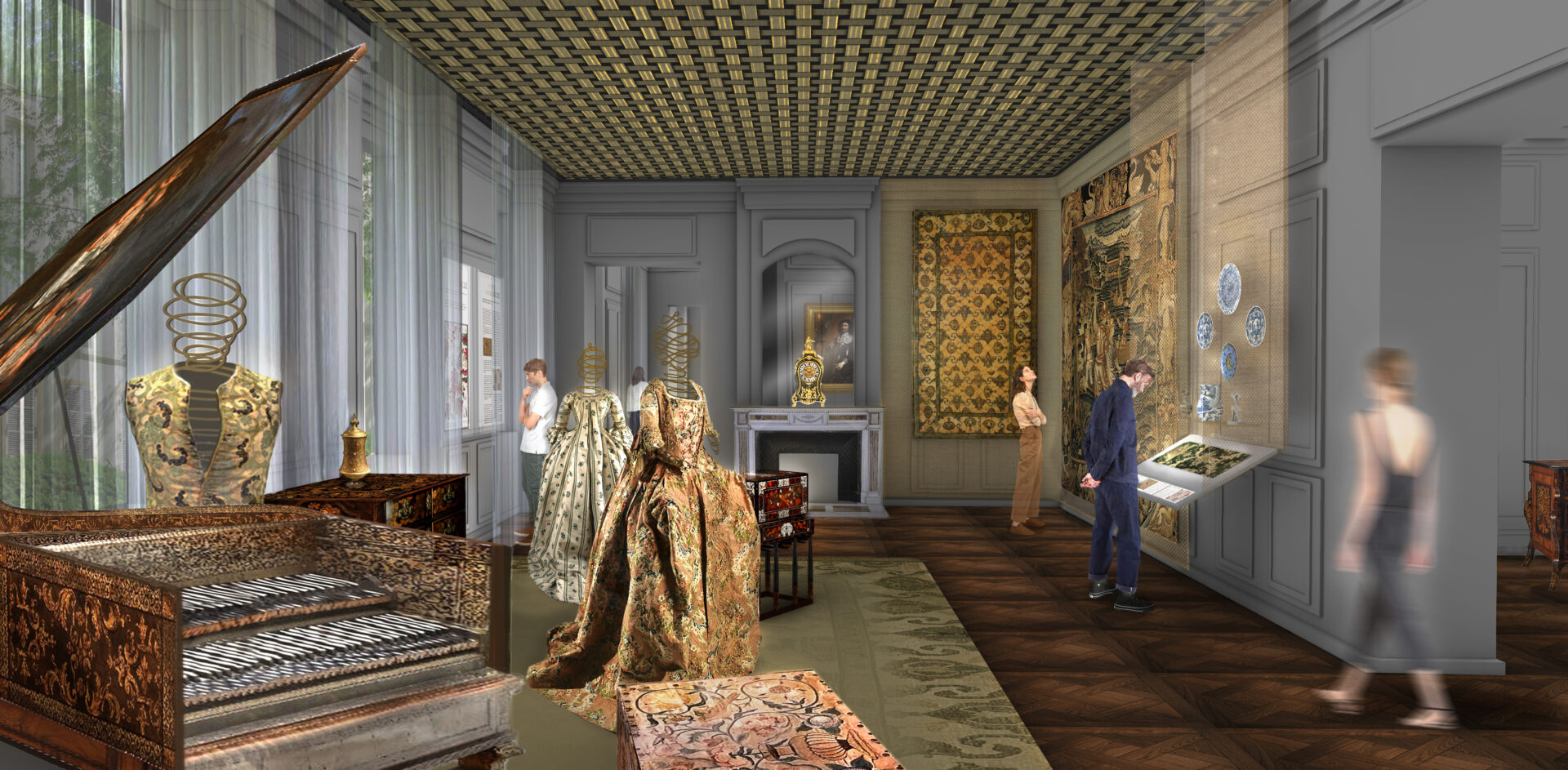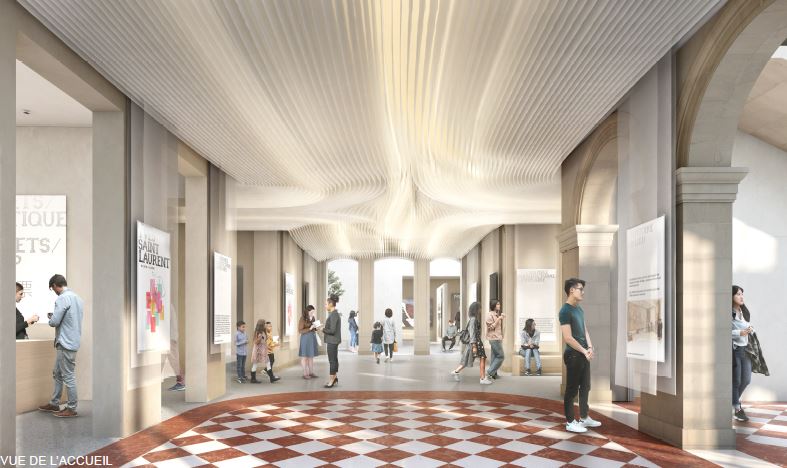
Close


Lyon - France
Light, foldable, compressable, the fabrics wrinkle, roll up, iron, fold: they are elusive as they escape the form and take a thousand. Always stretched or suspended (hanging, garment, veil, curtains, …), they do not stand but call for supports: hooks, pegs, cables, rods, body … In the museum’s permanent exhibition, the textiles of the collection float in a space that does not contain them: they belong to the world of movement, of travel, of wind, of bodies, of life.







Location
Lyon
Client
Region Auvergne-Rhône-Alpes
Year
2020
Phase
Concept
Surface
1 700 m²
Budget
3,16 M € HT
Mission
Design of the permanent exhibition
In a rich heritage context, this museum, conceived as a showcase of textile creation and technology, adapts to the site and the strong conservation constraints to create a fluid course and a fine presentation of the rich collections.
Man has always had a special relationship with textiles: they are our 2nd skin (clothing), our 3rd skin (drapes, curtains, sheets, household linen), our 4th skin (nomad tents).
With them, we weave intimate relationships: they dress our interiors, carry themselves in our luggage,
come back from our travels, are passed on from generation to generation, they are part of our great
and our little story(s). Their manufacture and the uses that we make of them testify to the genius and
the adventure of men over the centuries. Light, pliable, compressible, they crumple, roll up, iron, fold: they are elusive as they escape the form and take a thousand of them. Always stretched or suspended (curtain, clothing, veil, curtains, …), they do not stand but call for supports: hooks, poles, cables, rods, body … In the Hôtel Lacroix-Laval, the museum’s permanent exhibition, the textiles in the collection float “in a space that does not contain them”: they belong to the world of movement, travel, wind, bodies, life.
While the heritage setting of the hotel can be restrictive (low number of picture rails available, low ceiling heights, rooms for domestic use that impact the comfort of the visit or the security of the collections, etc.), the proposed scenography allows these constraints to be sublimated by providing creative and adapted solutions. In addition, it reserves its sanctuarized spaces for mediation devices centered on the history of the site, like a witness object of the collection.
Heritage sensitivity
The exhibition design device meets a double heritage requirement:
– it develops a global system of rigorous protection for the most sensitive collections,
– it is in line with the Hôtel Lacroix-Laval with its ISMH classified interiors, with a requirement for reversibility thanks to a “scenographic system” that respects and enhances the elements of heritage décor (floors, wall decorations, fireplaces, woodwork, mouldings, etc.).
Flexibility of the system
The proposed “exhibition design system” is a device made up of combinable elements (suspended showcases, rails, mobile picture rails, various supports) that optimizes the program’s expectations in terms of flexibility. Ideally and serenely, it can be adapted to all types of routes and all types of collections,
to accompany their rotations, to modulate the exhibition spaces, to vary the devices of mediation and
to interact with them.
Ease of use
By the care taken in its ergonomics and design, the “exhibition design system” makes its handling and programming very easy:
– It facilitates the task of the conservation staff to operate a quick rotation of the exhibited works: in the storage rooms, the collections are fixed on the supports at the same time as their mediation on the digital cartels is programmed to be quickly installed in the showcases and in the rooms;
– it facilitates the task of the technical maintenance and cleaning staff in the maintenance of the scenographic device;
– It facilitates the task of technical maintenance and cleaning staff in the maintenance of the scenographic system; it fluidifies the circulation of users and consequently facilitates the missions of security, safety and
guarding.
Digital programming of cultural mediation
The physical device of the exhibition design system is associated with a digital tool for managing the
interpretive planning mediation :
– it is programmable internally from the reserves,
– it allows to change exposures in an optimum time,
– it capitalizes on the memory of past exhibitions and announces upcoming exhibitions, in order to incite the
visitors to come and return to the museum.
Novation and regional textile industry
The project uses “smart textiles” produced in Auvergne-Rhône-Alpes as scenographic materials. Emblematic of a regional industry renowned for its innovation, they contribute to the modernity of the museum and legitimately embody the tribute paid to this heritage by a territory historically and geographically linked to the textile industry.
Eco-responsibility
The “exhibition design system” optimizes the rotation of collections without additional consumption of goods or services from outside the museum. Many of the materials – software and hardware – used for the arrangements are the result of research into an ecological transition from the industrial sector.
(virtuous fibers, recycling…).
The technical recommendations for lighting and multimedia equipment favour sustainable solutions (low energy consumption, no exposure to programmed obsolescence or changes in technology).
Textile Art’s Museum website
Request project PDF
Architects, leading firm :
Snohetta
Associated architects :
Z Architecture
Heritage architect :
Simon Arnou
Exhibition design :
Studio Adeline Rispal
Interpretive planning and preventive conservation :
A.S.K
Kitchen engineering and design :
Euclide
SCMC Technical studies office, thermal, electrical, structures :
Quadriplus
Acoustics :
Peutz
Economics of construction :
Cyprium
Lighting design :
Les Eclaireurs
Technical studies office for environnement :
EODD
BIM Manager :
Epigram
Are you looking for an exhibition designer for your project? Let's talk about it!
We will contact you within 48 hours
Do you wish to be supported in the preparation of a project?
Let's meet!